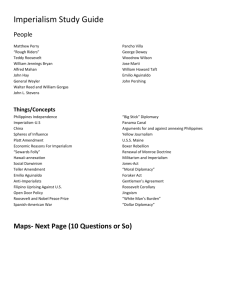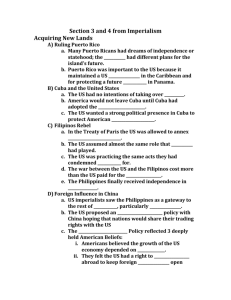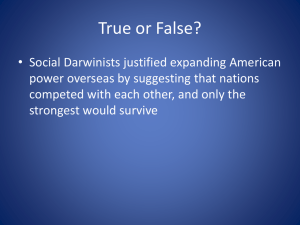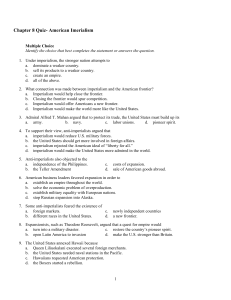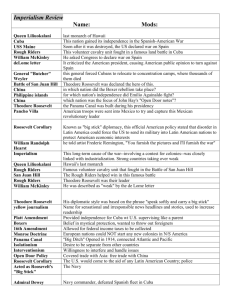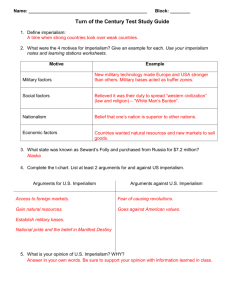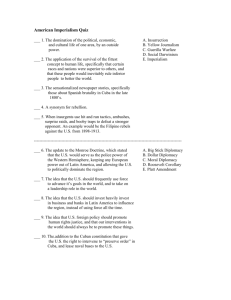American Cultures - Mrs. Gilbert`s Site
advertisement
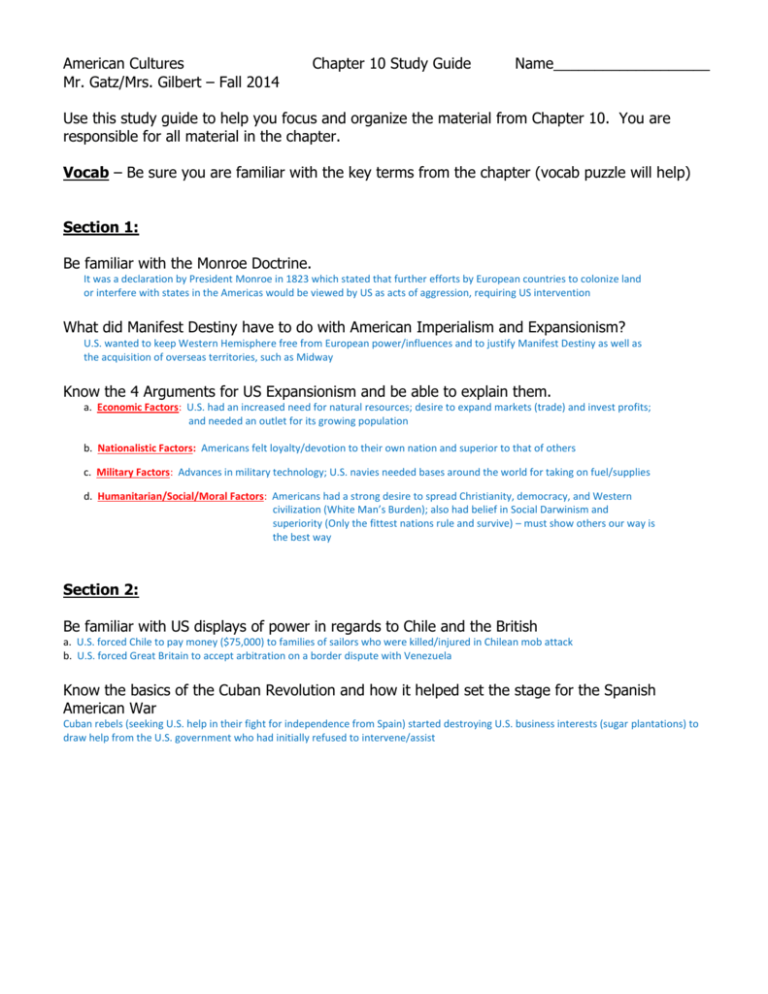
American Cultures Mr. Gatz/Mrs. Gilbert – Fall 2014 Chapter 10 Study Guide Name___________________ Use this study guide to help you focus and organize the material from Chapter 10. You are responsible for all material in the chapter. Vocab – Be sure you are familiar with the key terms from the chapter (vocab puzzle will help) Section 1: Be familiar with the Monroe Doctrine. It was a declaration by President Monroe in 1823 which stated that further efforts by European countries to colonize land or interfere with states in the Americas would be viewed by US as acts of aggression, requiring US intervention What did Manifest Destiny have to do with American Imperialism and Expansionism? U.S. wanted to keep Western Hemisphere free from European power/influences and to justify Manifest Destiny as well as the acquisition of overseas territories, such as Midway Know the 4 Arguments for US Expansionism and be able to explain them. a. Economic Factors: U.S. had an increased need for natural resources; desire to expand markets (trade) and invest profits; and needed an outlet for its growing population b. Nationalistic Factors: Americans felt loyalty/devotion to their own nation and superior to that of others c. Military Factors: Advances in military technology; U.S. navies needed bases around the world for taking on fuel/supplies d. Humanitarian/Social/Moral Factors: Americans had a strong desire to spread Christianity, democracy, and Western civilization (White Man’s Burden); also had belief in Social Darwinism and superiority (Only the fittest nations rule and survive) – must show others our way is the best way Section 2: Be familiar with US displays of power in regards to Chile and the British a. U.S. forced Chile to pay money ($75,000) to families of sailors who were killed/injured in Chilean mob attack b. U.S. forced Great Britain to accept arbitration on a border dispute with Venezuela Know the basics of the Cuban Revolution and how it helped set the stage for the Spanish American War Cuban rebels (seeking U.S. help in their fight for independence from Spain) started destroying U.S. business interests (sugar plantations) to draw help from the U.S. government who had initially refused to intervene/assist Be familiar with the events leading up to the Spanish American War: - Cuban Revolution – Cuban rebels (seeking U.S. help in their fight for independence from Spain) started destroying U.S. business interests (sugar plantations) to draw help from the U.S. government who had initially refused to intervene/assist - USS Maine – - Yellow Journalism – U.S. sent USS Maine over to Cuba (to appease the Cubans who were destroying U.S. sugar plantations because U.S. wouldn’t come to their aid in their fight for independence from Spain). However, USS Maine exploded. Even though no one really knows why or who did it, Spanish was blamed for it. Sensational news stories by competing newspaper journalists about the situation in Cuba (revolt and USS Maine explosion) strengthens Americans’ sympathy for Cuban rebels and sways their opinion to help them in their fight for independence from Spain - Other Reasons * * * * US’s need to protect their business/trade interests They (Spanish) had land in American territory, which was a violation of the Monroe Doctrine The Great White Fleet (sailing our ships around the world in 1907 to show off our powerful military (i.e., Navy) De Lome Letter ridiculing McKinley (called him “weak”) Post war challenges: - Philippines – Filipino rebels had fought alongside American troops in the war against Spain with the expectation that victory would bring Philippine independence. U.S., however, ignored their proclamations for independence, which created tensions to build between the rebels and American soldiers. This tension ultimately led to war in the Philippines (thousands were killed and many others were put in camps). - Cuba – Many Cubans felt betrayed by the U.S. in their quest for independence. So, they drafted a constitution that would end continued American involvement in Cuba. U.S. agreed only after a provision (known as the Platt Amendment) was made – Cuban government would not be allowed to enter foreign agreements/affairs; would allow U.S. to establish naval bases in Cuba to protect business interests; and would give U.S. the right to intervene when necessary (In other words, US leaves but retains control of Cuba). - Puerto RicoU.S. eventually gave Puerto Ricans more freedom and independence, and granted them U.S. citizenship. The U.S. also allowed them to have elections of legislature; however, U.S. government continued to have the power to appoint the executive, such as the governor, in Puerto Rico. Be familiar with how we dealt with Hawaii and Samoa. Hawaii was important for business – Hawaii and U.S. renewed a trade treaty, which allowed Hawaiin sugar to be sold duty-free in the U.S. Hawaii leased Pearl Harbor to U.S. as a fueling and repair station for their naval vessels. Marines and Dole employees overthrow Queen Lili’uokalani. In 1898 U.S. annexed Hawaii How did we deal with China? U.S. proclaimed an Open Door Trade Policy and Sphere of Influence in regard to China (China was critical for trade) Section 3: How did the US end up with the Panama Canal? French started the canal with a 25-year concession from Colombia (Panama was a province of Colombia). The French, however, gave up after 10 years and sold the rights to the U.S. Columbia was not pleased with the U.S. taking over for such a cheap price ($40 million) and refused to sign the deal. Thus, Roosevelt worked out a deal with Panamanians to start a rebellion allowing the US to recognize Panama as independent (the US became its protector). In return, Panamanians signed a treaty in 1903, which allowed the U.S. control of a 10-mile strip of land across Panama (the Panama Canal Zone), for $10 million Be sure you are familiar with the Roosevelt Corollary and how Roosevelt used it to expand the Monroe doctrine. In his 1904 extension of the Monroe Doctrine, Roosevelt denied the U.S. wanted any more territory, but rather prosperity and stability for all neighbors. He also stated that U.S. would intervene if necessary to keep this true. What approach did Roosevelt use in foreign policy and what was with the stick? Roosevelt used the “Big Stick Diplomacy” - The threat of military force allowed Roosevelt to conduct an aggressive foreign policy How did Roosevelt receive the Nobel Peace Prize? Roosevelt negotiated a treaty between Japan and Russia. Japan had started to overpower Russia in the Russo-Japanese war. Fearing China was next, Roosevelt stepped in and was able to get Japan to agree to getting small amount of land (from Russia). Russia also agreed to vacate Manchuria (a part of China) What was Taft’s approach to foreign policy and how did it differ from Roosevelt’s? Taft’s approach to foreign policy (how we handle foreign business/affairs) was “Dollar Diplomacy” – Maintaining stability through increasing American investments in foreign economies (substitute dollars for bullets). This approach was less aggressive than Roosevelt’s “Big Stick” foreign policy. What approach did Wilson use? Wilson used “Moral Diplomacy,” which was a return to using force (like Roosevelt did) to carry out his policies. Section 4: What impact did the events of post war Philippines have on US citizen’s ideas of Expansionism? Americans’ views of imperialism were mixed following the Spanish-American War. While some continued to support it for economic, military, social/moral, and nationalistic reasons, others opposed imperialism because they felt it was too costly, and U.S. superior attitude and strong desire to spread Christianity and democracy insinuated to those in other nations that they were weak and inferior, resulting in tensions/poor relations. Anti-imperialists also believed that imperialism would hurt American industries because of cheap goods being imported from overseas, and would cause American workers to compete for jobs with laborers who came to the U.S. from annexed territories. Finally, anti-imperialists felt that people in areas controlled by the U.S. should be entitled to the same Constitutional rights as U.S. citizens. The Anti-Imperialists had 3 basic arguments – be familiar with them a. Moral and Political Arguments: Imperialism disregards the “liberty for all” ideals of the U.S. It also denies Constitutional guarantees of other U.S. citizens. Anti-Imperialists feel the Constitution must follow the flag – people in areas controlled by U.S. should be entitled to the same Constitutional rights as U.S. citizens b. Racial Arguments: Imperialism Promotes racism by promoting superiority of Anglo-Saxon race who have a desire to bring American values to other countries. Southerners were also fearful of having an increase in other races (minorities) in the South c. Economic Arguments: Expansion was too costly - maintaining armed forces = more taxation, debt, and possibly even required military service. Also, immigrating laborers from the new territories would take jobs away from Americans (competing for jobs). In addition, cheap imported goods from annexed territories would hurt U.S. industries What parts of Imperialism appealed to people in the US? Imperialism appealed to the expeditionary mindset (frontier spirit) of Americans exploring the wild (Boy Scouts and Girl Scouts) and argued that imperialism was also necessary for economic and military gains (need to establish a world-class military) – Great White Fleet, which symbolized the pride of America, a world power How was Imperialism viewed by other countries? Having begun a pattern of international involvement, the U.S. often had to defend governments that were unpopular with local inhabitants (ex. – Latin America = Yankee Go Home). On the other hand, some countries began to turn to the U.S. for support (in order to stay independent). Through all of this, the U.S. needed to deal with their new-found power in the world.
